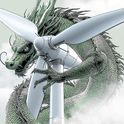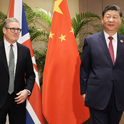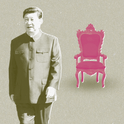Above: China needs a new economic model—but can its leaders deliver one?
On 1st October 2009 China will mark the 60th anniversary of Mao Zedong’s proclamation of the People’s Republic. The celebration will be orchestrated by film director Zhang Yimou, who ran the spectacular opening and closing ceremonies of the 2008 Beijing Olympics. Communist party leader and state president Hu Jintao will extol the country’s success, as economic figures show it roaring out of 2008’s economic downturn. Enthusiasts for the Chinese model will again proclaim it on course to overtake the west.
They have much to point to given the scale of growth in the past 30 years, and the economic reforms begun by Deng Xiaoping in 1978 remain overwhelmingly popular. China’s national pride is as intense as Britain’s at the height of the Victorian age. But Hu and his successors face a string of challenges on a scale that dwarf those of other world leaders. The disparities between the coastal and inland regions, and the country’s wealth gap, are wide. The task of restructuring the economy to boost consumption and lessen dependency on exports and infrastructure spending is only partially addressed. Health, education and welfare services barely function, despite a regime supposedly flush with cash.
These problems could well provoke the social instability the regime so fears; there are tens of thousands of grassroots protests each year. In this communist-ruled nation, workers receive a smaller share of national income than in the capitalist US. Last year saw 700,000 official labour disputes, reflecting poor treatment of staff and high-handed management. Corruption is endemic, and crime on an upward path. Progress cleaning up air, water and land has been patchy. Individual liberties have advanced, but the suppression of political dissent has increased, and legal reform has even been reversed—with judges told that their first duty is to serve the Communist party. Violence has again been used to keep Tibet and Xinjiang under Beijing’s control.
But hovering above all this is a deeper question: what is China’s Communist party for? The global crisis has presented Hu and the other eight members of the standing committee of the politburo with a test beyond economics. Their claim that the party is the only force capable of ruling China is at stake. With all the big banks under state control they have no financial sector scapegoats. With state behemoths enjoying monopoly control they cannot blame failures on private firms. With strict controls on investment from abroad, they cannot even point fingers at foreigners.
Yet the party’s ruling apparatus is far less efficient than its champions claim, or as those who vilify it as a Big Brother fear. The centre and the provinces are dislocated. The interests of local parties often run counter to national initiatives. (How many officials who own a share in a polluting factory would force it to buy expensive environmentally-friendly machinery, or see farmland-ownership rights changed if that would remove their ability to requisition fields?) China’s governance might not be democratic, but it remains complex.
Internationally, Hu and his colleagues have more feathers in their caps. Chinese demand fuels the economies of raw material producers in Australia, Africa and swathes of Latin America. Russia worries about the migration of Chinese people across their far eastern border, but Vladimir Putin cares more about selling oil and gas. Europe, meanwhile, has no discernible China policy, leaving Beijing free to cherry-pick round its capitals.
President Barack Obama did impose tariffs on Chinese tyres during September. But previous criticism from the US about the undervaluation of the yuan has stopped for the time being, as the Americans hope that the People’s Republic will continue to fund its record budget deficit. And Taiwan has stopped talking about independence under its new government, as Beijing uses economic co-operation to tempt the island back into its fold.
Back at home, and armed with a healthy fiscal balance, Beijing threw money at the economic downturn. The equivalent of $1 trillion in new loans were provided to local authorities and companies in the first half of 2009, treble the amount for the whole of 2008. The politburo thus laid the foundation for 8 per cent growth in 2009, a sharp recovery.
But short and long-term problems lurk behind these bullish numbers. Recent growth came mostly from spending on infrastructure and property, along with all those cheap government loans. But to sustain growth China’s 30-year dependence on trade requires an export revival, too; much of the bullish data on domestic demand now being advanced to show that China and the west have “decoupled” draws on the heavy state spending of the past year, not real increases in the growth of consumer spending. But, in the first eight months of 2009, trade with the US fell 16.4 per cent, with Japan 22 per cent and the EU 21 per cent.
There is a more fundamental threat, though. In its anxiety for short-term results, the leadership is failing to implement the very policies needed to keep up its impressive 30-year record. Low-margin, labour-intensive industries that should be being phased out are still being cushioned by tax breaks. Uncompetitive state monopolies received the bulk of the cheap capital handed out in the past 11 months, in return for promises of job preservation. Meanwhile, proposals to give farmers land-ownership rights have been pigeonholed to preserve the rural status quo.
At the top the party is also divided. Members of the politburo’s standing committee all want to see China hit 8 per cent growth this year. But there is little unity between Hu Jintao, who wants a more “harmonious society” with fewer disparities, and the powerful coastal export lobby, which wants growth, and cares less about the repercussions. At the last party congress in 2007 he was unable to impose his choice of successor, and saw a representative of the coastal group, former provincial chief Xi Jinping, emerge as the man most likely to take over when he steps down in 2012. Although there is no obvious threat to his position, Hu is the weakest party chief in the history of communist rule.
In a speech in September, Prime Minister Wen Jiabao, who sides with Hu, said that the recovery was “not yet steady, solid and balanced.” But the coastal faction is content to keep things as they are, and probably has the backing of most of China’s 80m middle class. Behind the 1st October celebration lies the question of whether the leadership is strong enough to move its country toward the new economic model that it needs. Given China’s importance for the world, it is a question that will affect us all far beyond this year’s anniversary.
On 1st October 2009 China will mark the 60th anniversary of Mao Zedong’s proclamation of the People’s Republic. The celebration will be orchestrated by film director Zhang Yimou, who ran the spectacular opening and closing ceremonies of the 2008 Beijing Olympics. Communist party leader and state president Hu Jintao will extol the country’s success, as economic figures show it roaring out of 2008’s economic downturn. Enthusiasts for the Chinese model will again proclaim it on course to overtake the west.
They have much to point to given the scale of growth in the past 30 years, and the economic reforms begun by Deng Xiaoping in 1978 remain overwhelmingly popular. China’s national pride is as intense as Britain’s at the height of the Victorian age. But Hu and his successors face a string of challenges on a scale that dwarf those of other world leaders. The disparities between the coastal and inland regions, and the country’s wealth gap, are wide. The task of restructuring the economy to boost consumption and lessen dependency on exports and infrastructure spending is only partially addressed. Health, education and welfare services barely function, despite a regime supposedly flush with cash.
These problems could well provoke the social instability the regime so fears; there are tens of thousands of grassroots protests each year. In this communist-ruled nation, workers receive a smaller share of national income than in the capitalist US. Last year saw 700,000 official labour disputes, reflecting poor treatment of staff and high-handed management. Corruption is endemic, and crime on an upward path. Progress cleaning up air, water and land has been patchy. Individual liberties have advanced, but the suppression of political dissent has increased, and legal reform has even been reversed—with judges told that their first duty is to serve the Communist party. Violence has again been used to keep Tibet and Xinjiang under Beijing’s control.
But hovering above all this is a deeper question: what is China’s Communist party for? The global crisis has presented Hu and the other eight members of the standing committee of the politburo with a test beyond economics. Their claim that the party is the only force capable of ruling China is at stake. With all the big banks under state control they have no financial sector scapegoats. With state behemoths enjoying monopoly control they cannot blame failures on private firms. With strict controls on investment from abroad, they cannot even point fingers at foreigners.
Yet the party’s ruling apparatus is far less efficient than its champions claim, or as those who vilify it as a Big Brother fear. The centre and the provinces are dislocated. The interests of local parties often run counter to national initiatives. (How many officials who own a share in a polluting factory would force it to buy expensive environmentally-friendly machinery, or see farmland-ownership rights changed if that would remove their ability to requisition fields?) China’s governance might not be democratic, but it remains complex.
Internationally, Hu and his colleagues have more feathers in their caps. Chinese demand fuels the economies of raw material producers in Australia, Africa and swathes of Latin America. Russia worries about the migration of Chinese people across their far eastern border, but Vladimir Putin cares more about selling oil and gas. Europe, meanwhile, has no discernible China policy, leaving Beijing free to cherry-pick round its capitals.
President Barack Obama did impose tariffs on Chinese tyres during September. But previous criticism from the US about the undervaluation of the yuan has stopped for the time being, as the Americans hope that the People’s Republic will continue to fund its record budget deficit. And Taiwan has stopped talking about independence under its new government, as Beijing uses economic co-operation to tempt the island back into its fold.
Back at home, and armed with a healthy fiscal balance, Beijing threw money at the economic downturn. The equivalent of $1 trillion in new loans were provided to local authorities and companies in the first half of 2009, treble the amount for the whole of 2008. The politburo thus laid the foundation for 8 per cent growth in 2009, a sharp recovery.
But short and long-term problems lurk behind these bullish numbers. Recent growth came mostly from spending on infrastructure and property, along with all those cheap government loans. But to sustain growth China’s 30-year dependence on trade requires an export revival, too; much of the bullish data on domestic demand now being advanced to show that China and the west have “decoupled” draws on the heavy state spending of the past year, not real increases in the growth of consumer spending. But, in the first eight months of 2009, trade with the US fell 16.4 per cent, with Japan 22 per cent and the EU 21 per cent.
There is a more fundamental threat, though. In its anxiety for short-term results, the leadership is failing to implement the very policies needed to keep up its impressive 30-year record. Low-margin, labour-intensive industries that should be being phased out are still being cushioned by tax breaks. Uncompetitive state monopolies received the bulk of the cheap capital handed out in the past 11 months, in return for promises of job preservation. Meanwhile, proposals to give farmers land-ownership rights have been pigeonholed to preserve the rural status quo.
At the top the party is also divided. Members of the politburo’s standing committee all want to see China hit 8 per cent growth this year. But there is little unity between Hu Jintao, who wants a more “harmonious society” with fewer disparities, and the powerful coastal export lobby, which wants growth, and cares less about the repercussions. At the last party congress in 2007 he was unable to impose his choice of successor, and saw a representative of the coastal group, former provincial chief Xi Jinping, emerge as the man most likely to take over when he steps down in 2012. Although there is no obvious threat to his position, Hu is the weakest party chief in the history of communist rule.
In a speech in September, Prime Minister Wen Jiabao, who sides with Hu, said that the recovery was “not yet steady, solid and balanced.” But the coastal faction is content to keep things as they are, and probably has the backing of most of China’s 80m middle class. Behind the 1st October celebration lies the question of whether the leadership is strong enough to move its country toward the new economic model that it needs. Given China’s importance for the world, it is a question that will affect us all far beyond this year’s anniversary.












